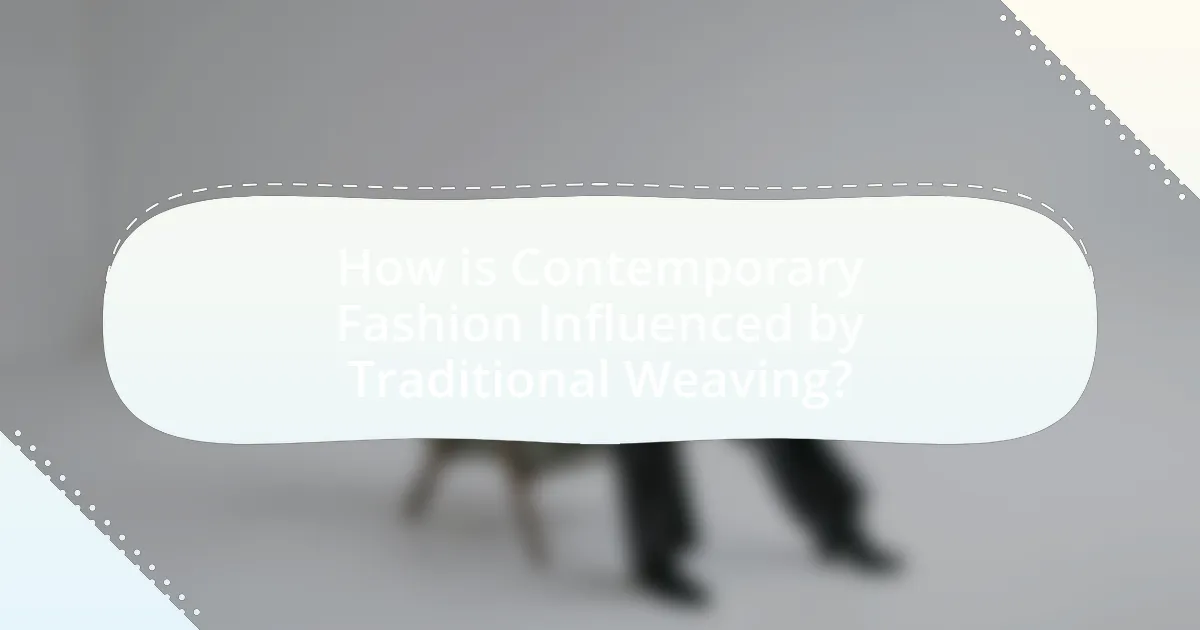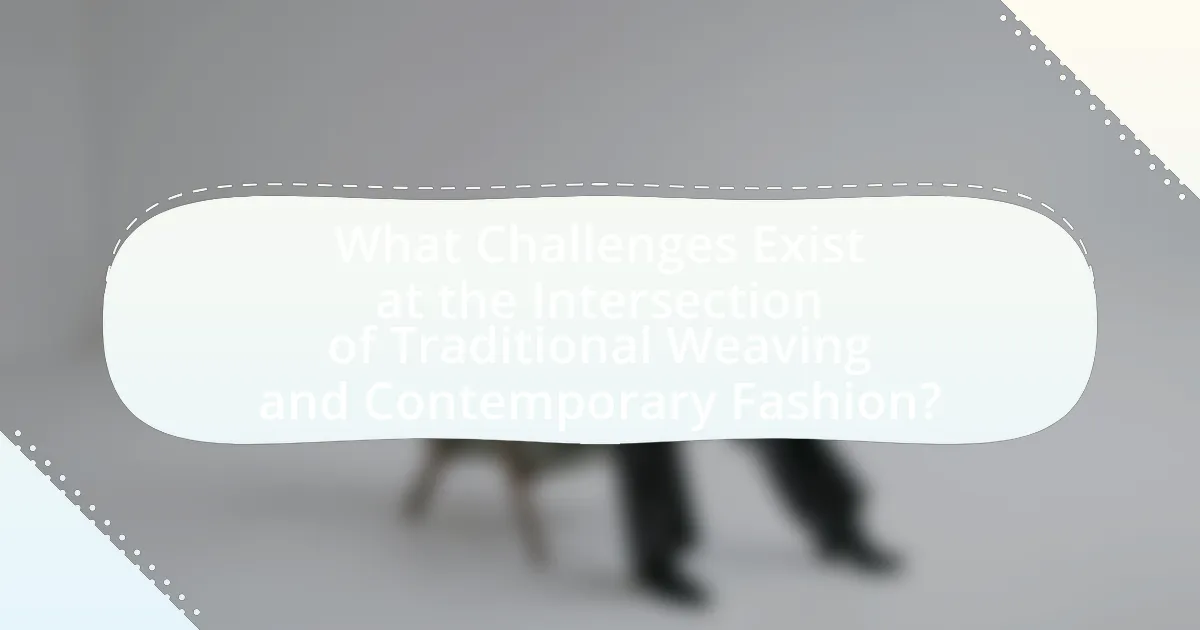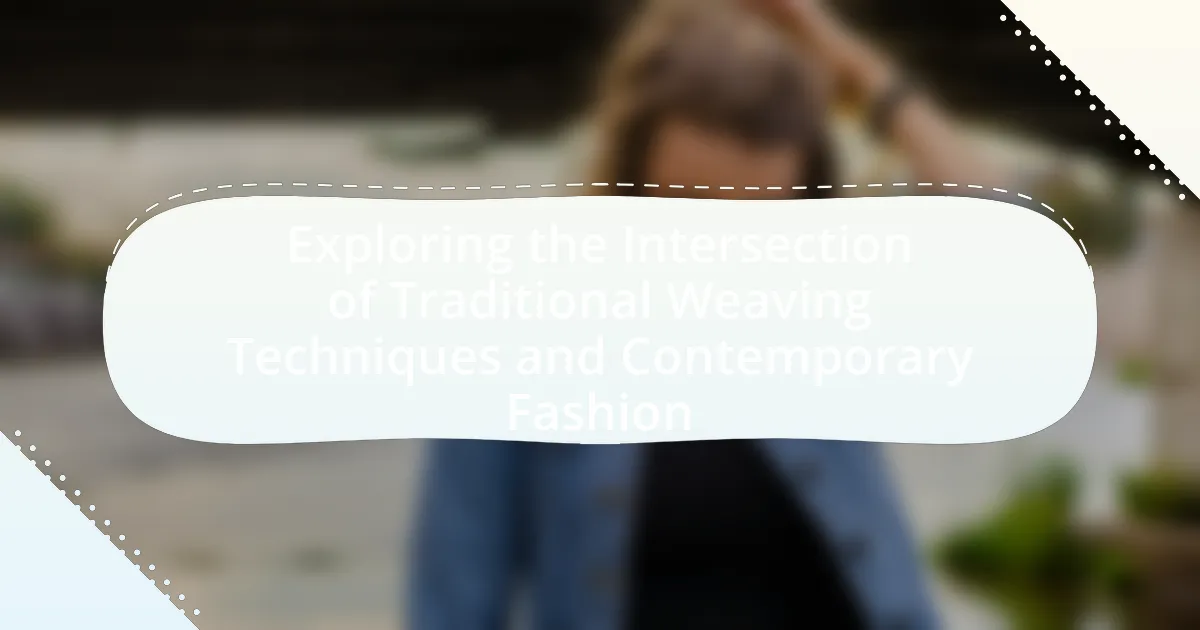The article explores the intersection of traditional weaving techniques and contemporary fashion, highlighting the historical significance, cultural diversity, and evolution of these methods. It examines various traditional weaving styles from different cultures, the materials commonly used, and the role of dyes in textile creation. The discussion includes how contemporary fashion incorporates these techniques, the challenges faced by traditional weavers in a globalized market, and the ethical considerations surrounding cultural appropriation and sustainability. Additionally, it outlines best practices for collaboration between designers and traditional artisans, emphasizing the importance of preserving cultural heritage while adapting to modern consumer demands.

What are Traditional Weaving Techniques?
Traditional weaving techniques are methods used to create textiles by interlacing threads on a loom or by hand. These techniques vary widely across cultures and often include practices such as plain weave, twill, and satin weave, each defined by the specific pattern of thread interlacement. For instance, the plain weave is the simplest form, where the weft thread passes over and under the warp threads alternately, resulting in a strong and durable fabric. Historical evidence shows that these techniques have been practiced for thousands of years, with archaeological findings indicating that weaving dates back to at least 5000 BCE in regions like Mesopotamia. The preservation of these techniques is crucial as they reflect cultural heritage and craftsmanship, influencing contemporary fashion by integrating traditional patterns and methods into modern designs.
How have traditional weaving techniques evolved over time?
Traditional weaving techniques have evolved significantly over time, transitioning from purely functional practices to intricate art forms that incorporate modern aesthetics and technology. Historically, weaving was primarily a means of producing textiles for clothing and household items, utilizing natural fibers and manual looms. As industrialization progressed in the 18th and 19th centuries, mechanized looms emerged, increasing production speed and allowing for more complex patterns.
In the 20th century, the introduction of synthetic fibers and digital technology further transformed weaving, enabling designers to experiment with new materials and techniques. Contemporary fashion now often blends traditional methods with innovative designs, as seen in the resurgence of artisanal craftsmanship and sustainable practices. This evolution reflects a growing appreciation for cultural heritage while adapting to modern consumer demands and environmental considerations.
What historical influences shaped traditional weaving methods?
Historical influences that shaped traditional weaving methods include cultural exchanges, technological advancements, and economic factors. For instance, the Silk Road facilitated the transfer of weaving techniques and materials between East and West, leading to the development of intricate patterns and styles in textiles. Additionally, the Industrial Revolution introduced mechanized looms, which transformed traditional hand-weaving practices by increasing production efficiency while also influencing design aesthetics. Furthermore, local customs and rituals often dictated specific weaving techniques, as seen in various indigenous cultures where weaving served both functional and ceremonial purposes. These historical contexts collectively contributed to the evolution of traditional weaving methods, making them rich in cultural significance and diversity.
Which cultures are known for their unique weaving techniques?
Cultures known for their unique weaving techniques include the Navajo, known for their intricate rugs and blankets; the Andean cultures of Peru, recognized for their vibrant textiles made using traditional backstrap looms; and the Japanese, famous for their silk weaving techniques such as Nishijin-ori. The Navajo weaving tradition dates back centuries and is characterized by geometric patterns and natural dyes. Andean weaving, particularly from the Quechua and Aymara peoples, incorporates rich colors and motifs that reflect their cultural heritage. Japanese silk weaving, especially in regions like Kyoto, showcases meticulous craftsmanship and has been refined over generations, often used in kimonos.
What materials are commonly used in traditional weaving?
Common materials used in traditional weaving include cotton, wool, silk, and linen. Cotton is widely utilized due to its availability and versatility, while wool is favored for its warmth and durability. Silk, known for its luxurious texture, is often used in high-quality textiles, and linen, derived from flax, is appreciated for its strength and breathability. These materials have been historically significant in various cultures, with cotton being cultivated for thousands of years and wool being integral to many pastoral societies.
How do natural fibers compare to synthetic materials in weaving?
Natural fibers, such as cotton, wool, and silk, generally offer superior breathability and comfort compared to synthetic materials like polyester and nylon in weaving. Natural fibers are biodegradable and often have a lower environmental impact during production, while synthetic materials can be more durable and resistant to wrinkles and stains. For instance, cotton is known for its softness and moisture-wicking properties, making it ideal for clothing, whereas polyester is favored for its strength and resistance to shrinking. Studies indicate that natural fibers can enhance the aesthetic appeal of woven fabrics due to their unique textures and colors, while synthetic fibers provide consistency and uniformity in production.
What role do dyes play in traditional weaving practices?
Dyes are essential in traditional weaving practices as they provide color and aesthetic value to textiles. The use of natural dyes derived from plants, minerals, and insects has been a longstanding tradition, influencing the cultural significance and identity of woven items. For instance, in many indigenous cultures, specific colors are associated with particular meanings or rituals, enhancing the symbolic nature of the textiles. Historical evidence shows that techniques for dyeing fabrics have been passed down through generations, preserving cultural heritage while also adapting to contemporary fashion trends.

How is Contemporary Fashion Influenced by Traditional Weaving?
Contemporary fashion is influenced by traditional weaving through the incorporation of age-old techniques and patterns into modern designs. Designers often draw inspiration from the intricate craftsmanship and cultural significance of traditional textiles, integrating them into contemporary garments to create unique, hybrid styles. For instance, the use of handwoven fabrics like ikat and brocade in high-fashion collections showcases a blend of heritage and modern aesthetics, reflecting a growing trend towards sustainability and authenticity in fashion. This influence is evident in collections by brands such as Etro and Missoni, which utilize traditional weaving methods to enhance their contemporary offerings, thereby preserving cultural narratives while appealing to modern consumers.
What are the key trends in contemporary fashion that incorporate traditional weaving?
Key trends in contemporary fashion that incorporate traditional weaving include the revival of artisanal craftsmanship, the use of sustainable materials, and the blending of cultural motifs with modern silhouettes. Artisanal craftsmanship is gaining prominence as designers seek to highlight the skill and heritage behind traditional weaving techniques, often collaborating with local artisans to create unique pieces. Sustainable materials, such as organic cotton and recycled fibers, are increasingly utilized in woven garments, reflecting a growing consumer demand for eco-friendly fashion. Additionally, contemporary designers are merging traditional patterns and techniques with innovative designs, creating a fusion that appeals to modern aesthetics while honoring cultural heritage. This trend is supported by the rise of brands like Bode and Etro, which emphasize the importance of storytelling through textiles and craftsmanship.
How do designers blend traditional techniques with modern aesthetics?
Designers blend traditional techniques with modern aesthetics by integrating age-old craftsmanship with contemporary design principles. This fusion often involves using traditional materials and methods, such as hand-weaving or dyeing, while applying modern silhouettes, color palettes, and functionality to create innovative fashion pieces. For instance, designers like Issey Miyake have utilized traditional Japanese pleating techniques in modern garment designs, showcasing how heritage can inform and enhance contemporary fashion. This approach not only preserves cultural heritage but also appeals to modern consumers seeking authenticity and uniqueness in their clothing.
What are some notable fashion collections that feature traditional weaving?
Notable fashion collections that feature traditional weaving include the Spring/Summer 2020 collection by Etro, which showcased intricate paisley patterns derived from traditional Italian weaving techniques. Another significant example is the Fall/Winter 2021 collection by Missoni, known for its vibrant knitwear that incorporates traditional Italian craftsmanship. Additionally, the 2019 collection by Issey Miyake highlighted Japanese weaving methods, emphasizing the artistry of textile manipulation. These collections exemplify how contemporary designers integrate traditional weaving into modern fashion, preserving cultural heritage while innovating design.
Why is the revival of traditional weaving important in contemporary fashion?
The revival of traditional weaving is important in contemporary fashion because it fosters cultural heritage and sustainability. Traditional weaving techniques often embody unique craftsmanship and storytelling that reflect the identity of specific communities. By integrating these techniques into modern fashion, designers not only preserve these cultural narratives but also promote ethical production practices. For instance, the use of handwoven textiles can reduce reliance on mass production, which is linked to environmental degradation. Additionally, the global fashion industry is increasingly recognizing the value of artisanal skills, with brands like Stella McCartney and Eileen Fisher incorporating traditional weaving into their collections to appeal to conscious consumers. This revival supports local artisans and contributes to the economic empowerment of communities, making it a vital aspect of contemporary fashion.
How does this revival impact cultural identity and heritage?
The revival of traditional weaving techniques significantly strengthens cultural identity and heritage by reconnecting communities with their historical craftsmanship. This resurgence fosters a sense of pride and belonging among artisans and consumers alike, as it emphasizes the unique narratives and skills passed down through generations. For instance, studies show that regions that actively promote traditional crafts experience a revitalization of local culture and increased tourism, which further supports the preservation of these practices. By integrating these techniques into contemporary fashion, designers not only honor their cultural roots but also educate a broader audience about the significance of these traditions, ensuring their survival in a modern context.
What are the environmental benefits of using traditional weaving techniques in fashion?
Traditional weaving techniques in fashion offer significant environmental benefits, primarily through the use of sustainable materials and reduced waste. These techniques often utilize natural fibers such as cotton, wool, and silk, which are biodegradable and have a lower environmental impact compared to synthetic fibers. Additionally, traditional weaving methods typically involve local craftsmanship, which minimizes transportation emissions and supports local economies.
Research indicates that traditional weaving can lead to less water and energy consumption during production compared to industrial methods. For instance, a study by the World Resources Institute highlights that handwoven textiles can consume up to 80% less water than machine-made counterparts. Furthermore, traditional techniques often emphasize quality and durability, resulting in longer-lasting products that reduce the frequency of purchases and, consequently, waste.

What Challenges Exist at the Intersection of Traditional Weaving and Contemporary Fashion?
Challenges at the intersection of traditional weaving and contemporary fashion include cultural appropriation, sustainability issues, and market accessibility. Cultural appropriation arises when contemporary designers use traditional patterns and techniques without proper acknowledgment or compensation to the original artisans, leading to disputes over ownership and authenticity. Sustainability issues are prominent as traditional weaving often relies on natural materials and methods that may not align with the fast-paced, mass-production model of contemporary fashion, which can lead to environmental degradation. Market accessibility is another challenge, as traditional artisans may struggle to compete with larger fashion brands that dominate the market, limiting their ability to reach wider audiences and secure fair pricing for their work. These challenges highlight the complexities of integrating traditional craftsmanship into modern fashion contexts.
How do economic factors affect traditional weavers in the fashion industry?
Economic factors significantly impact traditional weavers in the fashion industry by influencing their income stability and market access. For instance, fluctuations in raw material prices can directly affect production costs, leading to reduced profit margins for weavers. Additionally, economic downturns can decrease consumer spending on artisanal and luxury goods, further limiting the market for traditional woven products. According to a report by the International Labour Organization, the global demand for handmade textiles has been declining, which has pressured traditional weavers to adapt to cheaper, mass-produced alternatives. This economic pressure often forces weavers to compromise on quality or abandon traditional techniques altogether, threatening the preservation of cultural heritage in the fashion industry.
What are the challenges faced by artisans in a globalized market?
Artisans face several challenges in a globalized market, including competition from mass-produced goods, loss of traditional skills, and limited access to global distribution channels. The influx of cheaper, machine-made products undermines the pricing of handcrafted items, making it difficult for artisans to sustain their livelihoods. Additionally, as globalization promotes uniformity, traditional weaving techniques risk being overshadowed or forgotten, leading to a decline in cultural heritage. Furthermore, artisans often struggle to reach international markets due to inadequate infrastructure and lack of marketing resources, which limits their ability to showcase their unique craftsmanship. These factors collectively threaten the viability of artisan work in a globalized economy.
How can traditional weavers maintain their craft in a fast-fashion world?
Traditional weavers can maintain their craft in a fast-fashion world by emphasizing the uniqueness and cultural significance of their textiles. By creating limited-edition pieces that highlight traditional techniques, weavers can attract consumers seeking authenticity and sustainability. For instance, the global market for sustainable fashion is projected to reach $8.25 billion by 2023, indicating a growing consumer preference for ethically produced goods. Additionally, traditional weavers can leverage digital platforms to showcase their craftsmanship and connect with a broader audience, thereby increasing demand for their products. This approach not only preserves their craft but also educates consumers about the value of handmade textiles in contrast to mass-produced items.
What ethical considerations arise when integrating traditional techniques into contemporary fashion?
Integrating traditional techniques into contemporary fashion raises several ethical considerations, primarily concerning cultural appropriation, sustainability, and the preservation of artisan livelihoods. Cultural appropriation occurs when elements of a culture, particularly those of marginalized groups, are used without permission or understanding, potentially leading to exploitation and misrepresentation. For instance, when fashion brands adopt indigenous patterns or techniques without acknowledging their origins, they risk commodifying cultural heritage.
Sustainability is another critical consideration, as traditional techniques often emphasize craftsmanship and environmental stewardship. However, contemporary fashion’s fast-paced nature can undermine these values, leading to overproduction and waste. Brands must ensure that their use of traditional methods aligns with sustainable practices to honor the artisans’ original intent.
Lastly, the livelihoods of artisans who practice these traditional techniques must be protected. Ethical integration involves fair compensation and recognition for their work, ensuring that they benefit from the commercial success of their craft. According to a report by the International Labour Organization, fair trade practices can significantly improve the economic conditions of artisans, highlighting the importance of ethical considerations in this integration process.
How can designers ensure fair representation and compensation for traditional weavers?
Designers can ensure fair representation and compensation for traditional weavers by establishing transparent partnerships that prioritize the weavers’ cultural contributions and economic rights. This involves creating contracts that clearly outline payment terms, royalties, and the use of traditional designs, ensuring that weavers receive a fair share of profits generated from their work. For instance, the International Labour Organization emphasizes the importance of fair wages and ethical practices in the fashion industry, highlighting that equitable compensation fosters sustainable livelihoods for artisans. By actively involving traditional weavers in the design process and decision-making, designers can honor their expertise and heritage, leading to a more respectful and equitable collaboration.
What role does cultural appropriation play in the fashion industry?
Cultural appropriation plays a significant role in the fashion industry by influencing design practices and raising ethical concerns regarding the use of traditional cultural elements. Designers often draw inspiration from diverse cultures, which can lead to the commercialization of cultural symbols without proper acknowledgment or respect for their origins. For instance, the use of indigenous patterns or garments in high fashion can result in profit for brands while the original communities may not benefit or may even face cultural dilution. This dynamic has sparked debates about ownership, representation, and the need for cultural sensitivity, highlighting the importance of collaboration and fair compensation for cultural contributions in fashion.
What are best practices for incorporating traditional weaving techniques into modern fashion?
Best practices for incorporating traditional weaving techniques into modern fashion include collaborating with artisans to ensure authenticity, utilizing sustainable materials, and integrating contemporary design elements that respect cultural heritage. Collaborating with artisans allows designers to gain insights into the techniques and significance of traditional weaving, fostering a genuine connection to the craft. Sustainable materials, such as organic fibers or recycled textiles, align with modern consumer values and reduce environmental impact. Additionally, blending traditional patterns and methods with contemporary silhouettes can create innovative pieces that appeal to a broader audience while honoring the original techniques. This approach not only preserves cultural heritage but also enhances the uniqueness of modern fashion collections.
How can designers collaborate with traditional weavers effectively?
Designers can collaborate with traditional weavers effectively by establishing open communication and mutual respect for each other’s expertise. This collaboration can involve designers engaging weavers in the design process, allowing for the integration of traditional techniques with contemporary aesthetics. For instance, designers can conduct workshops where both parties share knowledge about materials, patterns, and cultural significance, fostering a deeper understanding of the weaving traditions. Additionally, successful collaborations often include fair compensation and recognition of the weavers’ contributions, which can enhance the sustainability of the partnership. Research indicates that such collaborative efforts not only preserve traditional crafts but also innovate within the fashion industry, as seen in projects that have successfully merged indigenous weaving techniques with modern design principles.
What resources are available for learning about traditional weaving techniques?
Books, online courses, and workshops are key resources for learning about traditional weaving techniques. Notable books include “The Art of Weaving” by A. C. H. H. and “Weaving: A Handbook for Beginners” by J. Smith, which provide foundational knowledge and practical guidance. Online platforms like Craftsy and Skillshare offer structured courses that cover various weaving styles and methods, allowing learners to engage with expert instructors. Additionally, local craft centers and community colleges often host workshops that provide hands-on experience with traditional weaving practices, fostering a deeper understanding of the craft. These resources collectively support the learning of traditional weaving techniques through diverse formats and expert insights.

Leave a Reply